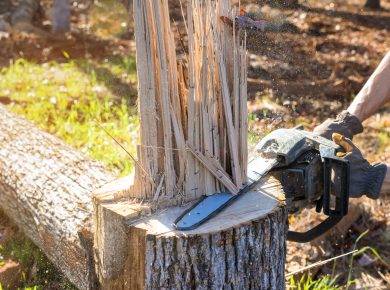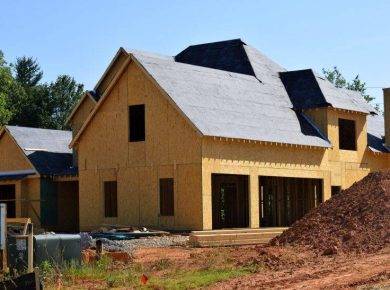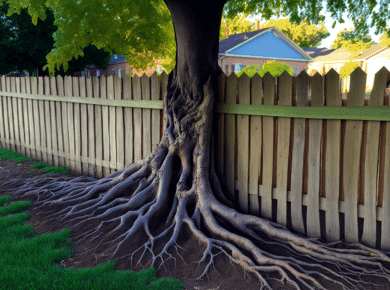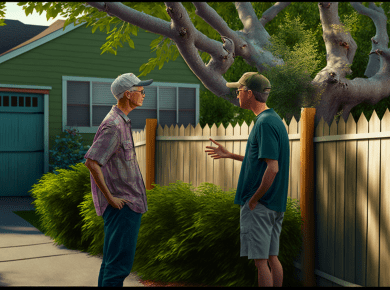Table of Contents
- Neighbor cut down my tree in South Dakota
- My neighbor cut my tree in South Dakota
- My tree branches overhang my property in South Dakota
- My neighbor damaged my tree on my property in South Dakota
- My neighbor’s tree roots or branches damaged my property in South Dakota
- Can my neighbor make me cut my tree?
- How can I get my neighbor to cut his dead tree in South Dakota?
- What happens if I cut my neighbor’s tree down in South Dakota?
- If a tree is cut down on my property by a neighbor how much money should I receive in damages?
Neighbor cut down my tree in South Dakota
A Neighbor Cut Down My Tree in South Dakota – What Can I Do?
If your neighbor cut down your tree in South Dakota, you have rights and you’re entitled to compensation. You may be wondering how to move forward and get the recompense you’re due. Below is a comprehensive guide to help you take the steps toward a successful resolution.
First Step: Contact a Specialist
When a neighbor has illegally cut down your tree, the best first step is to consult with a lawyer that practices in this type of case. They will assess the specifics of the situation, explain your rights and the available options, and work to get you the compensation you deserve.
Second Step: Collect Information
If you decide to move forward with the legal action, you’ll need to collect evidence, documents and other pertinent pieces of information. This includes must gather photographs of the tree and the surrounding property, statements and opinions from licensed arborists, and anything else that will help to prove that the damages and losses are the neighbor’s responsibility.
Third Step: Put Together a Demand Letter
Often, taking a stern yet courteous approach is the best way to get a neighbor to comply with the law. You will want to put together a demand letter laying out the facts of the situation and demanding payment for damages. This should be sent to your neighbor via certified mail marked return receipt requested.
Fourth Step: File a Complaint with the Local Official
If the offending neighbor is uncooperative, you can file a complaint with your local zoning office or public works department. This should include photographs, an explanation of what happened, and a citation of the laws that were broken. The other party will then have to officially respond to the complaint.
Fifth Step: File a Nonpayment of Debt Action
Your lawyer may advise that you file a nonpayment of debt action through small claims court. Here, the court will decide what kind of compensation you should receive, if any.
My neighbor cut my tree in South Dakota
If your tree was cut down on your property by your neighbor in South Dakota, you have rights as a landowner. In South Dakota, a fence or a dwelling house divides two adjoining owners’ land, and trees planted on either side of the fence or dwelling house are similarly divided. In other words, the branches of a tree that are on one side of the fence or dwelling house are the sole property of that owner and encroaching on that property with any type of tool is illegal and considered a trespass.
If it is found that your tree was cut down by your neighbor, contact the police to document the incident. The police will investigate and possibly provide an investigation report for you. It is also important to take photos or videos of the damage from multiple angles to help build a case.
The next step is to pursue the matter with your neighbor. Depending on how the tree was cut, you can assess the damages and the costs of resolving the issue. If the cutting was accidental, speak to the neighbor to come up with an agreement on how the issue can be resolved. If the cutting was intentional, demand compensation for the damages.
If the issue is not resolved through negotiation and more serious legal action needs to be made, contact a lawyer to represent you in court. A lawyer will help you to build a case in court with all the evidence you have collected.
You can also contact the State Forestry Commission if the tree cutting was done without a permit. It is important to contact them immediately as the Commission can take action and impose fines or other corrective measures.
It is important to know your rights and be prepared when neighbor issues arise. Being familiar with state laws and regulations concerning trees will help protect your property rights in the long run.
My tree branches overhang my property in South Dakota
If your tree branches are overhanging your property in South Dakota, it is important to figure out if you are responsible for trimming them. In most cases, it is the property owner’s responsibility to keep their tree from overhanging onto other properties.
The Standard Tree Pruning Rule applies to South Dakota property owners. This rule states that an owner may trim or remove the branches of a neighbor’s tree without permission up to the property line. However, a property owner is responsible for any damage to a neighbor’s tree when trimming.
If there are large tree branches hanging over your property, you may need to have them trimmed by a professional. Make sure you hire a licensed and insured tree service professional in South Dakota to carry out the work.
Before trimming any of the branches, consider if any of your neighbors have invested their time and money into landscaping their property. If so, you may want to consider a more strategic approach when trimming your tree.
South Dakota law requires that you do not reduce the amount of sunlight for your neighbor’s garden or yard. You are also limited to trimming the branches up to the property line without permission from the owner of the tree. For any branch which goes past the property line, you must get permission from the owner of the tree before doing any trimming.
Finally, make sure that you properly dispose of any branches or debris from the trimming. You will want to double check with your local municipality for any disposal regulations that apply.
Following the Standard Tree Pruning Rule for South Dakota and the tips included in this guide will ensure that the tree branches that hang over your property in South Dakota are managed appropriately.
My neighbor damaged my tree on my property in South Dakota
Tree damage from a neighbor can be a troublesome and difficult process. If the damage to the tree is severe and caused by a neighbor in South Dakota, steps should be taken to resolve the issue.
First, you must assess the damage. Make sure you photograph and record the damages left on your tree prior to taking any action.
Second, contact your neighbor and inform them of the damages they have caused. Ask them to personally help to repair the damages or to pay for the costs associated with doing so.
Third, contact an arborist if the damages are more serious to get an expert opinion on the extent of the damage done. The arborist report will be important if a legal dispute arises.
Fourthly, obtain a legal opinion if the issue is not resolved amicably. Many times, there are local laws that dictate how neighbors should act in certain reserve yard situations. You may also be able to bring a claim against the neighbor for negligence or trespass.
Lastly, depending on the value of the tree, it may be worthwhile to pursue a claim to recover lost or damaged property. Mediation or arbitration can be used to resolve the dispute without going to litigation.
The most important step is to work with your neighbor to resolve the situation. Often times these issues can be solved amicably and it is best to avoid a drawn-out legal battle if at all possible. If the damage is severe and your neighbor is unwilling to take responsibility, then you may have to pursue a legal claim.
My neighbor’s tree roots or branches damaged my property in South Dakota
1. Look at South Dakota Laws: Examine relevant South Dakota laws to determine how to handle your situation since every state has its own laws when it comes to trees and neighborly disputes. South Dakota law states that if a tree falls on or causes damage to a neighbor’s property due to disease, wind, or natural causes, it is the responsibility of the landowner on whom the tree stands. In the case of roots or branches extending onto the property of the neighboring homeowner, a court order may be necessary to determine if the damage was culpable or incidental.
2. Notify your Neighbor: Contact your neighbor and inform them of the damage to your property. Be sure to document the conversation and if possible, have a witness. If no agreement can be reached between the two parties, contact a lawyer and seek legal counsel.
3. Determine If Your Neighbor Is at Fault: If you are unable to reach an agreement with your neighbor, you may need to hire an arborist to assess the tree in question. An arborist will be able to determine if the roots or branches were growing in a manner that was likely to cause the damage before it happened (e.g., roots growing under a sidewalk, tree too close to a structure, etc.).
4. Seek Legal Help: If the tree is determined to have caused the damage, the neighbor may be responsible for reimbursing the property owner for repairs and costs. If the parties are unable to reach an agreement out of court, consulting a lawyer may be necessary. A lawyer may be able to help you understand your legal rights and options, as well as what compensation you may be legally entitled to.
5. Prevent Future Damage: Once the matter has been settled, it is important to take steps to prevent future damage. Consider planting a tree or shrub in an area that will not interfere with any of your neighbor’s property or taking preventive measures such as trimming back branches. You may also want to consult an arborist to determine if your neighbor’s tree is in need of any kind of care or treatment to keep it healthy and mitigate any additional damage.
Can my neighbor make me cut my tree?
It depends on the laws and regulations of your state, county and city. Most states have neighborhood tree ordinances which regulate the planting and maintenance of trees. Some cities also have special rules with regard to tree removal, so it is important to check with your local city hall before making any decisions.
If the tree was planted by you or your neighbor, it is important to understand the implications of moving it. It may be that your neighbor has the right to demand that you cut the tree down or trim it back, so it is important to look at all of your options before proceeding.
If the tree was planted before the relationship between both of you, then it may be considered a joint asset and there might be a legal obligation to maintain it. In this case, it is best to find out the specifics of the local laws regarding tree planting.
If, however, the tree was planted by your neighbor, then it is possible that they have the right to require that you maintain the tree if it is growing onto their property. The laws with regard to this situation can vary greatly and it is best to consult both a lawyer and your local city hall if the situation is unresolved.
In some cases, your neighbor may be able to obtain an injunction from the court that requires you to cut or trim the tree back. If this happens, it is important to take all necessary steps to comply with the court’s order and ensure the tree is properly maintained.
Ultimately, it is important to understand the specific regulations and laws in your area. If the situation persists, it may be necessary to seek legal advice or contact your local city hall for guidance.
How can I get my neighbor to cut his dead tree in South Dakota?
1. Start by speaking to your neighbor in a cordial manner. You don’t want to come on too strong or you may end up in a conflict. Give them an opportunity to explain why they haven’t removed the dead tree yet and try to be understanding of their point of view.
2. Show them the laws and regulations in your area as they relate to dead trees. Every state has different laws regarding dead trees and it’s important to apprise your neighbor of the rules in your area. Give them a copy of the laws and see if that helps them understand the urgency.
3. Explain the safety hazards that can stem from a dead tree. In South Dakota, dead trees can pose a serious risk if you experience a heavy snowfall, because their weakened branches can collapse onto power lines or fences. Your neighbor will be more likely to take action if they understand the risks.
4. Offer to help if possible. Sometimes a neighbor will be more willing to take action if you pitch in to help. Maybe you can offer to cover the cost of cutting down the tree or at least pay for the removal of the debris.
5. If all else fails, contact your local government agency to report the dead tree. Many government agencies, such as the fire department or the Department of Natural Resources, have the authority to force a homeowner to remove a dead tree if it poses a safety risk.
What happens if I cut my neighbor’s tree down in South Dakota?
In South Dakota, it is illegal to cut down a tree on another person’s property without their express permission. Depending on the jurisdiction, there could be serious legal ramifications for cutting down a neighbor’s tree without their consent.
The first step is to contact the neighbor to see if they gave you permission to cut it down. If they did not give you permission, you should talk to the authorities to see what legal action they might take against you.
If you are found guilty of illegally cutting a tree down in South Dakota, you could be charged with vandalism. Vandalism is considered a criminal offense that can include fines and jail time, depending on the severity of the situation.
If the tree you cut down caused damage to your neighbor’s property, you could also be responsible for reimbursing them for the costs associated with the damage. The amount of your reimbursement depends on the type of damage and the value of the tree.
In addition, you may need to pay a penalty for cutting the tree down illegally. This penalty may vary from state to state, but it typically involves money.
Overall, it is important to remember that it is illegal to cut down a tree on another person’s property without their permission in South Dakota. If you are found guilty of this crime, you could face fines, jail time, and civil liability for damages.
If a tree is cut down on my property by a neighbor how much money should I receive in damages?
If you have a tree on your property and your neighbor cuts it down without consulting you then you are entitled to claim for the value of the tree plus any damage to the surrounding area including loss of future growth. There will be no claim if the tree was pollarding, or if it was damaged beyond repair by a storm or insect infestation.
If a tree is cut down on my property by a neighbor how much money should I receive in damages?
Valuation of trees:
The measure of damages is governed by the Trees Act 2006 which provides that damages can be assessed on two bases:
1. The cost of replacing the tree with one of similar age and size; or
2. The cost of providing another remedy which is less than the cost of replacing the tree.



